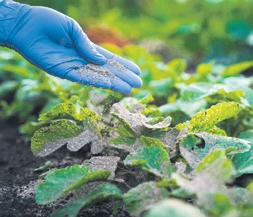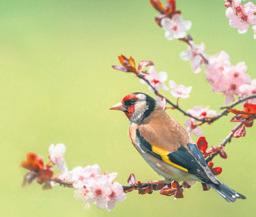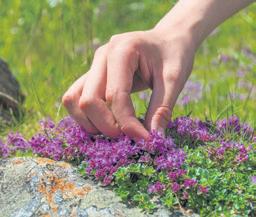
5 minute read
Sustainable Gardening Practices for Spring: Cultivating a Greener Future
by Christine Kemfort, contributing writer
Spring is the perfect time to start fresh in your garden and bring it back to life. With nature waking up from its winter slumber, it’s an ideal opportunity to introduce sustainable gardening practices that not only benefit your garden but also the environment. From water conservation to biodiversity, here are some ways to create an eco-friendly and sustainable garden this spring.
1. Soil health: The foundation of sustainability
Healthy soil is the cornerstone of any thriving garden, and it can be maintained sustainably. One of the best ways to ensure your soil remains nutrient-rich and healthy is by composting. Composting your kitchen scraps, lawn clippings, and garden waste reduces waste sent to landfills while enriching your garden with natural nutrients. But make sure to follow local laws when it comes to composting.

Additionally, avoid chemical fertilizers that can harm the environment. Instead, consider using organic alternatives. These will provide your plants with the nutrients they need without damaging the ecosystem.
Tip: Mulch your garden with organic materials such as straw, leaves, or grass clippings to help retain moisture, suppress weeds, and keep soil temperature stable.

2. Native plants: A friend to the environment
Native plants are a key element of sustainable gardening. These plants have adapted to thrive in your local climate and soil, requiring fewer resources like water, fertilizers, and pesticides. They also support local wildlife, including bees, birds, and butterflies.
Focus on planting native species that are resilient and less maintenance-intensive compared to non-native varieties.
Tip: Research which native plants thrive in your area by checking with local garden centers or nurseries.
3. Water conservation: Use it wisely
Watering your garden efficiently is crucial, especially as climate change causes more unpredictable weather patterns. One of the most effective ways to conserve water in your garden is by installing a drip irrigation system. Unlike traditional sprinklers, drip irrigation delivers water directly to the plant’s roots, reducing evaporation and runoff.

Collecting rainwater with a rain barrel is another effective method to utilize natural water sources.
Tip: Water your plants early in the morning or late in the evening to minimize water loss due to evaporation.
4. Pollinator-friendly practices: Support bees and butterflies
Insects like bees, butterflies, and moths play a crucial role in pollinating the plants in your garden. Without them, many of the fruits, vegetables, and flowers we enjoy wouldn’t be able to thrive. You can attract and support pollinators by planting a variety of nectar-rich flowers, such as lavender, sunflowers, and daisies.
Avoid using chemical pesticides that can harm pollinators. Instead, choose natural alternatives or try companion planting to protect beneficial insects.
Tip: Planting a variety of flowers that bloom at different times during the spring and summer ensures your garden offers continuous support to pollinators throughout the season.
5. Reducing lawn areas: Less is more
Traditional lawns require large amounts of water, fertilizers, and pesticides to stay lush and green, contributing to environmental degradation. One sustainable alternative is to reduce the size of your lawn and replace it with low-maintenance, drought-resistant ground covers or perennial plants.
Another option is to plant a vegetable or herb garden. Growing your own food reduces the carbon footprint associated with food transportation and packaging, while also promoting biodiversity in your garden.
Tip: Choose drought-tolerant plants for a low-maintenance, sustainable ground cover.

6. Eco-friendly pest control: Keep it natural
Rather than reaching for chemical pesticides, consider natural ways to keep pests under control. Encourage beneficial insects like ladybugs, lacewings, and predatory beetles that feed on harmful pests like aphids.

Another natural solution is companion planting — this involves planting certain plants next to each other to deter pests. For example, planting marigolds alongside tomatoes can help repel nematodes, and basil can deter mosquitoes and aphids.
Tip: Use homemade, non-toxic solutions such as garlic spray or soapy water to deter common pests without harming the environment.
7. Sustainable tools and practices: Gardening with less impact
Consider the tools you use in your garden. Electric or manual tools are more eco-friendly compared to gas-powered ones, which release harmful emissions. Invest in high-quality, durable tools that will last for many years, reducing the need for frequent replacements.

Additionally, choose non-toxic, biodegradable products for your garden. From compostable planters to organic fertilizers, every small change you make can reduce your environmental impact.
Tip: Avoid plastic plant pots when possible and opt for biodegradable or recyclable alternatives.
8. Gardening with wildlife in mind: Create a habitat
A sustainable garden goes beyond just being eco-friendly — it also creates a habitat for wildlife. Planting trees, shrubs, and flowers that attract birds, insects, and small animals can provide them with food and shelter. Consider building a birdhouse or a bee hotel to give local wildlife a place to rest.
Tip: Install a small pond or birdbath to provide a water source for animals, especially during dry spells.
Final thoughts: A greener future starts in your garden
Spring is the perfect time to embrace sustainable gardening practices. By making mindful choices, such as planting native species, conserving water, and reducing chemical use, you can create a garden that’s not only beautiful but also good for the planet. These small changes add up, making a significant positive impact on both your local ecosystem and the world around you.
So, grab your gardening gloves, roll up your sleeves, and start planting for a greener, more sustainable future this spring!











